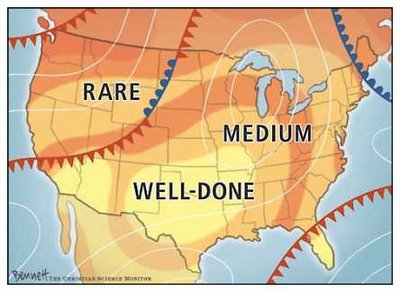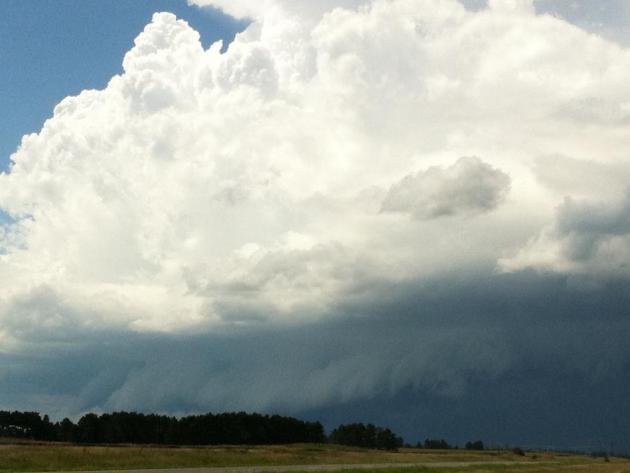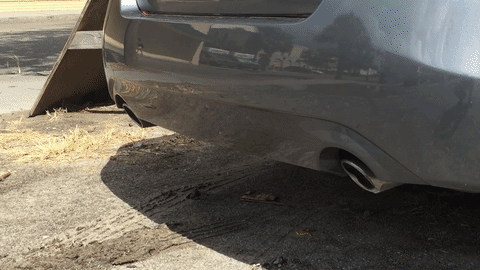83 F. average high on July 21.
88 F. high on July 21, 2016.
July 22, 1972: Copious amounts of rain fall in parts of Minnesota, with 10.84 inches of rainfall in 24 hours at Ft. Ripley. 14 inches of rain is measured at a farm in Morrison County.

The Importance of Summertime Situational Awareness
A recent flash flood tragedy in Arizona, with 10 members of one family swept to their deaths by a surging wall of water, got me thinking about the limits of technology.
What could they have done differently, so they'd still be with us today? Apps on smart phones and a portable NOAA weather radio increase the odds of hearing a warning in time but there are still gaps in coverage. You can call up Doppler radar on your phone now, and take note of a distant storm's track before hitting the water. On volatile summer days it's a good idea to have a designated "weather-watcher", someone who can tap you on the shoulder when it's time to go. The grim reality: in spite of Doppler and streamlined warning services there technology won't save us, the government won't save us. Its up to each of us to take responsibility for our personal safety.
A stray T-storm can't be ruled out today, but winds swinging around to the northwest will pull more comfortable air into town Sunday and Monday, as dew points dip into the 50s.
The worst of the heat stays south of Minnesota into early August, but odds still favor a real summer. MSP has picked up 9 days above 90F so far in 2017. Average is 11. 2016 brought 13 days above 90.
A little perspective: 1988 saw an astounding 44 days above 90 degrees!
90-Degree Days in the Twin Cities. So far in 2017 a total of 9 days at or above 90F. This compares to a summer average of 11 days, but 13 days > 90F were reported last year. To keep things in perspective during the heat wave and drought of 1988 a total of 44 days at or above 90F were observed at MSP!
Adequate Soil Moisture for the MSP Metro. Rainfall amounts are running close to average since the start of meteorological summer on June 1.

Dangerously Hot. Check out the heat index on Saturday: 106F at Wichita and Kansas City, 113F at St. Louis. Today appears to be the worst day for heat and humidity, followed by slow improvement by early next week.

Midpoint of Summer. Temperatures tend to peak roughly 1 month after the Summer Solstice, although there is some variation across North America (hottest weather in south Texas and south Florida doesn't come until August).
Editorial: Envisioning a Chicago Future Without Massive Flood Damage. Development of land in flood-prone suburbs is coming back to bite much of Chicago this summer as waves of heavy thunderstorms produce widespread flooding. Here's an excerpt of an Op-Ed from the Chicago Sun Times Editorial Board: "The massive flooding ravaging parts of the Chicago area is doing hundreds of millions of dollars of damage, and all because of a basic failure of planning. It is foolish that so many homes and businesses stand in low-lying areas that are susceptible to flooding. It need not be that way. Among possible solutions, we support a call for the federal government — which already is spending billions of dollars on flood insurance for some properties that flood again and again — to buy out more homes and businesses that repeatedly flood and raze them as the owners voluntarily move elsewhere. The Metropolitan Water Reclamation District, on its own, already has done some of this..."
Photo credit: "Flooding continued Monday in Fox Lake, Ill., along the Chain O' Lakes."
(Gilbert R Boucher II/Daily Herald via AP)

Shocking Secrets About Lightning, Exposed. I enjoyed an article written by Matthew Cappucci, writing for Capital Weather Gang. Here are a couple of excerpts: "...The phenomenon is a spectacular sight to behold, and was widely viewed on May 18 in Bethany, Okla., at the “antenna farm.” Here, more than a dozen thousand-foot-high towers are all crammed into a three-square-mile plot of land, and the results can be electrifying. On this particular day, at least 20 bolts of lightning shot upward into the cloud from the towers, especially strange considering the storm had already left. Some even assert that this type of lightning is caused by humans, since it is almost exclusively caught leaping from man-made structures...However, the charge of lightning can offer quite a bit of key information about the strike. Positive flashes, for instance, are considered particularly dangerous, because they originate from the top of severe thunderstorms. Here, the “electric potential” is strong enough to give rise to supercharged lightning bolts, oftentimes three- to 100-times more powerful than ordinary lightning. These “sparks on steroids” have a high enough peak current that they are able to travel many miles from the parent storm cloud, posing a danger to folks that may find themselves under otherwise clear skies and sunshine..."
Photo credit: "Lightning strikes in Cape Cod Bay, Mass., on May 23, 2014." (Matthew Cappucci)
New Forecast Models Could Give You An Extra Hour to Hide From a Tornado. This may be overstating the capability, at least looking out 5-10 years. And early research suggests that if the warnings are too long many people are tempted to get into vehicles to try to escape the area vs. hunkering down in the basement, which is obviously counterproductive (last place you want to be during a tornado is in your car or truck). Here's an excerpt from ScienceAlert: "...Warn on Forecast could eventually provide severe weather warnings up to three hours in advance, say the researchers working on the technology, and in the case of its first trial run it gave Oklahoma residents 90 minutes to brace themselves for large hail and tornadoes. "We had a picture of the storms and their evolution before they became life-threatening," says one of the team, science operations officer Todd Lindley. "We used this model guidance to forecast with greater lead time and greater confidence." Today, tornado warnings are issued by forecasters manually studying satellite data and volatility in the atmosphere, but WoF takes in more data and analyses its patterns in ways human brains aren't equipped to..."
Image credit:" WoF produces a "firehose" of data, say researchers. NOAA.
Photo credit: Niccolò Ubalducci/Flickr.com
Photo credit: "Recycling only delays the day a plastic object ends up in a landfill." (Reuters/China Daily)
Healthier Living Could Reduce Worldwide Dementia by a Third, Report Says. The Washington Post has more detail: "Up to one-third of the world’s dementia cases could be prevented by addressing factors such as education, hypertension, diet, hearing loss and depression over the course of a person’s lifetime, according to a new report presented Thursday at the Alzheimer’s Association International Conference in London. The report was compiled by the first Lancet Commission on Dementia Prevention and Care, which brought together 24 experts from around the world to review scores of studies and synthesize them into a model showing how lifestyle modification could reduce dementia risk. Around 47 million people have dementia worldwide, and that number is projected to triple by 2050..." (File photo: BBC).
Photo credit: "Jude Sparks sitting beside the fossilized remains of a Stegomastodon." Peter Houde.
* Then again, maybe this is all perfectly natural. Check out the (R-rated) Reddit comments. I've never seen anything like this in the USA. Either way coal sure does make for colorful train rides.


TODAY: Sticky sun, still humid with a T-storm risk. Winds: NW 7-12. High: 88
SATURDAY NIGHT: Drying out, a bit better out there. Low: 65
SUNDAY: More clouds than sun, more comfortable. Winds: NW 8-13. High: 79
MONDAY: Bright sun, very little wind. Winds: SE 5-10. Wake-up: 58. High: 81
TUESDAY: Unsettled, few T-storms around. Winds: S 7-12. Wake-up: 63. High: 86
WEDNESDAY: Partly sunny, seasonably warm. Winds: W 5-10. Wake-up: 65. High: 84
THURSDAY: T-storms rumble across southern MN. Winds: NE 5-10. Wake-up: 66. High: 83
FRIDAY: Blue sky, fairly comfortable. Winds: NE 3-8. Wake-up: 63. High: 84
Climate Stories...
In Miami, Battling Sea Level Rise May Mean Surrendering Land. Reuters explains: "...Mayor
Philip Levine, who was elected on his promises to protect Miami Beach
from rising waters, says the city will invest even more if necessary in
adaptation strategies to protect more than $40 billion worth of
properties. But on the other side of Biscayne Bay, in Miami’s Shorecrest
neighborhood, a novel idea is taking shape: Instead of trying to keep
the water out of the notoriously flood-prone area, officials are
considering surrendering some developed land to nature, to accommodate
inevitably rising seas. The idea is controversial and expensive, as it
involves demolishing properties and moving people and businesses away.
But officials say it’s a long-term solution, unlike Miami Beach’s
temporary remediation efforts..."
File photo: NOAA.
Gov. Candidate Chris King: Climate Change is Biggest Threat to Florida's Economy.
With rising seas (not a climate model, but actual observations of water
levels rising) Florida is ground zero for climate change, an issue that
may help to sway elections one way or another in the future. Here's an
excerpt from Tampa Bay Times: "Democratic gubernatorial candidate Chris King today made his case for
how economic growth and fighting climate change go hand in hand. His
rivals for the Democratic nomination, Gwen Graham, Andrew Gillum and
possibly Philip Levine, make climate change and environmental protection
top priorities too..."
Climate Change Will Be Very Bad for Dallas County.
Virginia, Louisiana, Texas, Arizona and California are additional
states already seeing early impacts of a warming climate and/or rising
seas. Here's an excerpt from D Magazine in Dallas, Texas: "...A new study led
by climate scientists and economists at the University of Chicago and
the University of California, published last month in Science, drives
that point home. It takes a detailed county-by-county look at how
climate change will affect communities across the U.S., finding that
Texas and the South are especially vulnerable to projected economic
losses caused by global warming, as desirable jobs move to wealthier and
cooler climes to the west and north, and an unpredictable climate
wreaks havoc on agriculture and industry. (An emboldened mosquito population is another issue.)..."
File photo: D Magazine and Michael Samples.
Glacier National Park Still Has Glaciers, For Now. I want to get out there to see the glaciers ASAP, after reading a story at USA TODAY: "There’s
good news and bad news regarding the future of Glacier National Park.
The bad news has to do with science. Long-term studies indicate that the
famous ice fields that inspired the park’s name are, in fact,
shrinking. And, yes, the same research predicts that all 25 named
glaciers likely will be gone by 2030. The good news, if you can call it
that, is that these large-scale changes are still at least a decade
away, and the park has plenty of grandeur to go around until then.
Grandeur like blue-green Lake McDonald, which is more than 9 miles long
and sits like a mirror in one of the most picturesque valleys of the
West. And the knee-buckling vistas at Many Glacier, the heart of the
park, from which visitors can spy jagged mountains, those aforementioned
glistening glaciers, and (if you’re lucky) abundant wildlife, including
moose, bighorn sheep, mountain goats and grizzly bears..."
Photo credit: "Park visitors eating dinner at Cracker Lake, a glacial-fed lake in Glacier National Park's backcountry." Credit: Jacob Frank/National Park Service.

Innovate, Award-Winning Way to Visualize CO2 Emissions.
Of course, one of the many challenges of talking about a warming
blanket of CO2: the gas is clear and odorless - almost invisible, unless
you have the right equipment. The Post and Courier explains: "...Featuring in-depth reporting about plankton, sea-rise and coral reefs, the “Every Other Breath” series featured the use of a rare thermal imaging camera
to show readers what emissions of carbon dioxide look like from buses,
planes and other everyday sources of CO2. The Post and Courier is said
to be the first newspaper or magazine to use such a device for a news
story..."
Photo credit: "As part of
The Post and Courier's Every Other Breath series, the newspaper
obtained a one-of-a-kind thermal imaging camera from FLIR to document
everyday sources of invisible CO2 emissions."


Climate Change is Killing Us Right Now. Not as much in the USA, not yet, but the author of a story at New Republic argues that even under a best-case scenario nearly half of humanity will be regularly exposed to potentially deadly levels of heat by 2100: "...These scenarios are supported by the science. “For heat waves, our options are now between bad or terrible,” Camilo Mora, a geography professor at University of Hawaii at Manoa, told CNN last month. Mora was the lead author of a recent study, published in the journal Nature, showing that deadly heat days are expected to increase across the world. Around 30 percent of the world’s population today is exposed to so-called “lethal heat” conditions for at least 20 days a year. If we don’t reduce fossil-fuel emissions, the percentage will skyrocket to 74 percent by the year 2100. Put another way, by the end of the century nearly three-quarters of the Earth’s population will face a high risk of dying from heat exposure for more than three weeks every year..."
Paying People to Not Cut Down Trees Pays Off, Study Finds. Deforestation is another (very) significant source of CO2, since fewer trees means less of a carbon sink available (trees breathe in CO2 and exhale oxygen). Here's an excerpt from InsideClimate News: "Across dozens of villages in rural Uganda, researchers have explored what they believe could be an easy way to help tackle climate change: paying landowners to leave their trees standing. The concept is simple—and controversial, because critics say it can foist the burden of cutting emissions onto developing countries. But the researchers, led by an economist from Northwestern University, found that these financial incentives—or "payments for ecosystems services"—have both a climate and economic benefit, something that had not been firmly established in previous studies..."
Methane Seeps Out as Arctic Permafrost Starts to Resemble Swiss Cheese. Here's the intro to a story at InsideClimate News: "Global warming may be unleashing new sources of heat-trapping methane from layers of oil and gas that have been buried deep beneath Arctic permafrost for millennia. As the Earth's frozen crust thaws, some of that gas appears to be finding new paths to the surface through permafrost that's starting to resemble Swiss cheese in some areas, scientists said. In a study released today, the scientists used aerial sampling of the atmosphere to locate methane sources from permafrost along a 10,000 square-kilometer swath of the Mackenzie River Delta in northwestern Canada, an area known to have oil and gas desposits. Deeply thawed pockets of permafrost, the research suggests, are releasing 17 percent of all the methane measured in the region, even though the emissions hotspots only make up 1 percent of the surface area, the scientists found..."
Image credit: "In parts of northern Canada's Mackenzie River Delta, seen here by satellite, scientists are finding high levels of methane near deeply thawed pockets of permafrost." Credit: NASA Earth Observatory.
Robert Redford: "To Save the World, Start Small". The solutions will be organic, bottom-up, not top-down, dictated more by economics than politics. Here's an excerpt of an Op-Ed at Time.com: "...Our choice is no longer the economy vs. the environment. It is now the economy and the environment. Addressing climate change will help both. Ignoring it risks both. This is not a revelation in many of our cities and towns. There, the idea that climate change is “political” is dissolving. If you are the mayor of a coastal town that now floods regularly or a farming town that just experienced several “once-in-a-hundred-years” droughts within a couple years, politics is the furthest thing from your mind. This shouldn’t come as a surprise. Mayors are usually our most direct connection to government. They see the immediate ways in which our communities are threatened and reinvented. Fighting climate change can be opportunity for such reinvention..."
Image credit: NASA/NOAA/GSFC/Suomi NPP/VIIRS/Norman Kuring.
2017 Is So Unexpectedly Warm It Is Freaking Out Climate Scientists. Joe Romm explains why at ThinkProgress: "Normally,
the hottest years on record occur when the underlying human-caused
global warming trend gets a temporary boost from an El Niño’s enhanced warming in the tropical Pacific. So it’s been a surprise to climate scientists that 2017 has been so remarkably warm — because the last El Niño ended a year ago. The National Oceanic and Atmospheric Administration (NOAA) reported
Tuesday that the first half of 2017 was the second-warmest January-June
on record for Earth, topped only by 2016, which was boosted by one of
the biggest El Niños on record..."
Graphic credit: "January–June 2017 global surface temperatures (compared to the 20th century average) in Degrees Celsius." CREDIT: NOAA.
Photo credit: "New research suggests that if immediate and significant emissions reduction efforts are undertaken — amounting to a decline in global carbon output by at least 3 percent annually starting in the next four years — then less carbon extraction will be needed." (Martin Meissner/AP).
Photo credit: "Goodrich rides on the Hi-Line along U.S. 2 in northern Montana. Glacier National Park can be seen in the distance." (Courtesy David Goodrich).
No comments:
Post a Comment